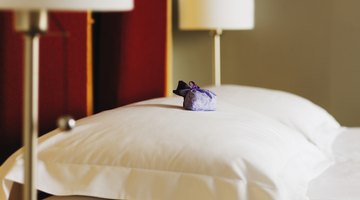What Is a Bedding Sham?
A bedding sham is a pillowcase with a facade. Shams are fancier, more substantial covers for bed pillows that serve a decorative purpose; they match the duvet, pull together the colors in the room or help set a theme.

Shams are sold in the bed-linens department or in specialty shops in sizes to slip over regular bed pillows and some more decorative pillow shapes.
Sizing Up Shams
Purchase pillow shams in sizes that slip over the most common bed pillows. A standard sham measures 26 inches by 20 inches to fit a standard pillow. A king sham is 36 by 20 inches and usually is used for both queen and king pillows. A Euro shame -- or European pillow sham -- fits the large square 26-by-26-inch pillows used for decoration and as extra support while reading in bed.
Open and Shut Case
Most shams open in the back, not on one side like a regular bed-pillow cover. The front is the fancy part if the sham is very decorative, and the back is plainer, with an overlapped open slit in the middle into which you slip the pillow. A sham may have a zipper closure, which is more likely when the sham is designed to be a tight fit. Conventional decorative bedding sets typically have a bedspread or duvet cover and two matching pillow shams made from the same fabric.
Historic Textiles
Pillow shams are nothing new. Shams made centuries ago by skilled sewers and designers are collectibles and museum pieces today. The pillow covers made excellent needlework practice projects with a practical application. Young girls might learn lace making and apply the developing skills to creating one or more shams. A fine linen sham, embroidered with a family initial, might have gone into a young woman's hope chest. Fanciful patchwork shams mirrored the patterns of handmade quilts. A decorative style of art needlework called redwork was a very popular sham technique in late 19th-century America; the outline of a pattern or design was stitched on a white or cream fabric background in high-contrast thread. Red was the common thread color because a red dye available at the time was colorfast and did not bleed into the rest of the fabric.
Stitch Your Own Sham
Anyone with some interesting fabric, a good idea and minimal sewing skills can create decorative pillow shams. Fabrics with some body, such as linen, matelasse and brocade, are suited to pillow shams. Also suitable are inset panels of embroidery or ethnic textiles; hand-painted or appliqued fabrics; grain-sacking with oversize side-button closures; romantic eyelet bordered in ruffles and threaded with satin ribbon; salvaged pieces of elaborate silk saris, Japanese kimonos or Chinese robes; sentimental commemorative T-shirts; or pieced-together period designs such as zigzags or chevrons.
The Drip Cap
- A bedding sham is a pillowcase with a facade.
- Shams are fancier, more substantial covers for bed pillows that serve a decorative purpose; they match the duvet, pull together the colors in the room or help set a theme.
- Pillow shams are nothing new.
- Fanciful patchwork shams mirrored the patterns of handmade quilts.
- Fabrics with some body, such as linen, matelasse and brocade, are suited to pillow shams.
References
Resources
Writer Bio
Benna Crawford has been a journalist and New York-based writer since 1997. Her work has appeared in USA Today, the San Francisco Chronicle, The New York Times, and in professional journals and trade publications. Crawford has a degree in theater, is a certified Prana Yoga instructor, and writes about fitness, performing and decorative arts, culture, sports, business and education .
Photo Credits
- Stockbyte/Stockbyte/Getty Images
- Stockbyte/Stockbyte/Getty Images
More Articles



